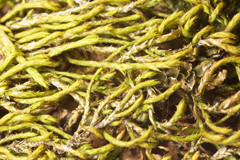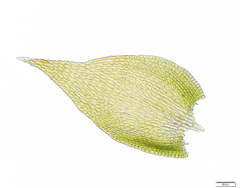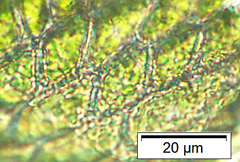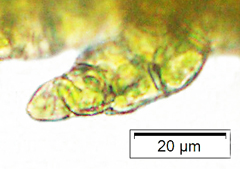Plants of the Gila Wilderness
Presented in Association with the
Western New Mexico University Department
of Natural Sciences
Leptopterigynandrum austro-alpinum Müller Hal.
Family: Taxiphyllaceae, formerly Leskeaceae
Status: Native
Synonyms:
None
Leptopterigynandrum austro-alpinum looks very much like Pseudoleskeella tectorum-- a small pleurocarp growing on rocks with quite small leaves and a short and forked costa. Leptopterigynandrum austro-alpinum are nearly julaceous when dry, compared to P. tectorum which has a more chained appearance. The leaf cells of Leptopterigynandrum austro-alpinum are 2-3 to 1 in length rather than the shorter 1-2 to 1 leaf cells of P. tectorum. There are foliose pseudoparaphyllia present in Leptopterigynandrum austro-alpinum, though they can be difficult to spot. Leptopterigynandrum austro-alpinum has roughened, micropapillose laminal cell walls, though this is difficult to appreciate at any magnification less than 400:1. Leptopterigynandrum austro-alpinum is found at middle to upper elevation in rocky crevices.
Please click on an image for a larger file.

Leptopterigynandrum austro-alpinum, 4X macro, dry, photo Russ Kleinman, Kelly Allred & Karen Blisard, White Mountains, Three Rivers Trail near Fall Creek on boulder, February 25, 2015

Leptopterigynandrum austro-alpinum, 200x photomicrograph of leaf, photo Russ Kleinman, Kelly Allred & Karen Blisard, White Mountains, Three Rivers Trail near Fall Creek on boulder, February 25, 2015

Leptopterigynandrum austro-alpinum, 400x contrasted photomicrograph of leaf cells with micropapillae, photo Russ Kleinman, Kelly Allred & Karen Blisard, White Mountains, Three Rivers Trail near Fall Creek on boulder, February 25, 2015

Leptopterigynandrum austro-alpinum, 400x photomicrograph of foliose pseudoparaphyllia, photo Russ Kleinman, Kelly Allred & Karen Blisard, White Mountains, Three Rivers Trail near Fall Creek on boulder, February 25, 2015
Back to the Index



